It doesn’t have to be difficult substituting sweeteners. Let’s talk about swapping sweeteners with this Ultimate Guide to Substituting Sweeteners and Sugar.
Nothing is quite like sugar. No sweetener makes a batch of cookies quite like sugar. Carmel is next to impossible without sugar.
I guarantee nothing tastes and acts just like sugar, but we can find some decent replacements. Substituting sweeteners and sugar isn’t as hard as it sounds!
Substituting Sweeteners: What? Why would I want to get rid of sugar?
I don’t think any of us really want to get rid of sugar. I certainly didn’t. But if you’re reading this post, you (like me) have probably found that sugar doesn’t do nice things to your body.
My body is not happy with me when I eat sugar…
Increased inflammation
Headaches
Fatigue
Achey body
and more.
Every single time I eat a treat with sugar, I wake up the next day with a sugar hangover. No thanks.
While I miss some of the properties of sugar, there are some things I absolutely don’t miss. And I’ve found some pretty decent replacements, so I can have a sweet treat every now and again without feeling like I went out binge drinking the night before.
Guide to Substituting Sweeteners
You ready to get cooking? All the sweeteners I’ll be referring to in this guide are heat-stable. That means you can cook with them.
I’ll be skipping the ones that aren’t heat stable because why use a sweetener if you can’t make a cookie with it?
Substituting Sweeteners: Sugar Alcohols (Xylitol and Erythritol)
One of my personal favorite classes of sweeteners are sugar alcohols: xylitol and erythritol. While these sweeteners sound like something created in the lab, they’re actually derived from corn husks and/or the bark of birch trees.
That said, they must be highly processed to become the pretty crystal sugar-like substance that lands in your pantry. So, calling them a “natural sweeteners” is a bit far-fetched. (Some people do call them natural. Whatever makes you feel better, I guess). That said, the benefits of occasionally using them outweighs their drawbacks for my particular situation.
Unlike many sugar substitutes, xylitol and erythritol don’t have a funky aftertaste. That said, they both can cause a “cooling” sensation—the feeling in your mouth you get when eating a peppermint. You’ll find that erythritol presents a stronger cooling sensation than xylitol. I’ll give you a tip for reducing or eliminating of this cooling sensation.
Both of these sugar substitutes melt in high heat and don’t caramelize. For this reason your baked goods often don’t have a nice chewy quality unless you balance them with the other ingredients appropriately.
Both xylitol and erythritol also have a tendency to absorb moisture and thus your recipes will dry out more quickly. This means 2 things:
(1) You’ll need to remove your food from the oven a bit early in order to maintain softness.
(2) You should be sure to eat your treats soon after making them.
Replacing Sugar with Erythritol
Erythritol is about 70% as sweet as sugar. That means, when you substitute erythritol for sugar, you need to use more. For every 1 cup of sugar you’ll want to use 1 1/3 cup of erythritol.
And if you’re concerned about calories, you’ll be happy to know that erythritol has just 6% of the calories of sugar.
Replacing Sugar with Xylitol
Xylitol can be substituted in 1:1 ratio for sugar, making it super easy to substitute in your favorite recipes (no math required). So for every 1 cup of sugar, you’ll use 1 cup of xylitol.
While not as impressive as erythritol as far as being low-calorie, xylitol is still much lower in calories than sugar. It contains just 40% of the calories in sugar.
Xylitol is definitely one of my favorites on the list, not just because it looks like sugar and tastes great, but because it has some nice health benefits too.
Note: Xylitol, like many other foods, is toxic to dogs. Don’t feed your canine friends treats made with xylitol.
How to Get Rid of the Cooling Sensation (and get a better overall taste)
How do you get rid of that blasted cooling sensation from these sugar alcohols? It’s one thing if you’re making sugar-free peppermint patties, but nobody wants that in the chocolate cake they made for their husband’s birthday.
It’s really not that hard and you’ll find that you’ll also get a better, more true sweet taste by following this one easy trick: when baking, I cut down on the amount of sugar alcohol I use and add a bit of stevia.
For every 1 cup of sugar, I’d substitute 1 cup of erythritol and 1/4 teaspoon of pure stevia extract (the kind with no fillers) or 3/4 cup of xylitol and 1/4 teaspoon of pure stevia extract.
Combining sweeteners in this way will give you a much better sweet flavor and cut the cooling sensation.
Substituting Sweeteners: Stevia
While I enjoy using a little stevia in my tea for a bit of sweet or adding a little to sauces, I’ve found that baking with stevia only can be a little tricky.
If you’re using pure stevia extract, it doesn’t have the appropriate bulk with which to bake, and your cakes and cookies won’t turn out right. Also, if you use too much stevia, you’ll get the dreaded bitter aftertaste stevia is so criticized for.
It’s difficult to provide you with an exact ratio for stevia. Even if you’re using a pure stevia extract, the exact sweeteness can vary from brand to brand. I use NuNaturals pure stevia extract as it’s one of the brands I’ve found whose flavor is consistent and not bitter as long as I don’t use too much.
With NuNaturals 3/4 teaspoon is equal to approximately 1 cup of sugar. So if sweetening my tea, I use just a tiny sprinkle. If baking, I use the ratio I mentioned above of xylitol or erythritol and stevia.
The popular Truvia Spoonable is a stevia and erythritol blend. Buy the raw ingredients and mix them together yourself for big money savings.
Substituting Sweeteners: Splenda
I used to think Splenda was all-that-and-a-bag-of-chips. For real? A sweetener you could cook with? Zero calories and no sugar? Awesome.
That was also back in the day before I really didn’t think much about chemicals I was putting in, on, or around my body. Splenda, while not the worst thing in the world, is some pretty shady stuff.
And if the fact that it’s concocted in the laboratory isn’t enough to turn you off, then maybe its horible aftertaste will.
But if you still want to cook with Splenda, you can substitute it at a 1:1 ratio for sugar. For every 1 cup of sugar, use 1 cup of Splenda—but don’t say I didn’t warn you.
Other Sweeteners (that will still raise your blood sugar)
Up until this point in the article we’ve discussed substituting sweeteners that have a minimal to nil impact on your blood sugar. This is one of the big reasons people tend to want to substitute sugar for sweeteners—they want to get off the blood sugar roller coaster.
The sugars in this portion are all natural, but they will still raise your blood sugar—though not necessarily the same way table sugar does.
Replacing Table Sugar with Honey
Honey is fabulous. I could just eat delicious raw honey by the spoonful, but that probably wouldn’t help me out too much.
When it comes to baking with honey, you’ll want to decrease the amount you use because it’s actually sweeter than sugar. For every 1 cup of sugar you’ll want to use 3/4 cup of honey.
You’ll also note that you can’t cream honey, so it will often result in denser baked goods that don’t rise as well as those made with sugar. You can use 1/4 teaspoon of baking soda to help offset this issue and give your baked goods some better height.
Honey will also impart a distinct flavor to your baked goods. There are several varieties of honey, some stronger than other. Take that into consideration when thinking about what you’re making and if the honey flavor will enhance or detract. I love honey in my son’s favorite grain-free banana cake with peanut butter frosting recipe.
Replacing Table Sugar with Turbinado Sugar
Turbinado sugar is made from the first pressing of the sugar cane, so is much less refined than common table sugar. It retains some of the natural molasses of sugar, so it has a slight carmel flavor. If you’re looking for a less refined sugar, this is the way to go.
Turbinado sugar is more coarse and crunchy than refined sugar, so you’ll have to take some extra time when creaming your sugar. You can use it in a 1:1 substiution for sugar. For every 1 cup of sugar, use 1 cup of turbinado.
Replacing Brown Sugar with Muscovado Sugar
The brown sugar you purchase from the store is processed white table sugar, with molasses added back in. Muscovado, on the other hand, is unrefined cane sugar in which the molasses isn’t removed.
Muscovado makes a perfect substitute for brown sugar and has even more depth of flavor. The color is usually darker (as you can see in the above image) than most brown sugars because it has even more molasses content.
You can substitute muscovado 1:1 for brown sugar in your recipes.
Replacing Table Sugar with Coconut Sugar
Coconut sugar is made from the sap collected from the flower buds of the coconut palm. Don’t worry: it doesn’t taste like coconut at all because it doesn’t come from the coconut itself, but the flower. It does, however, have a subtle brown-sugar-ish taste to it.
This natural sugar has a low glycemic index (35), which means it’s not going to do the crazy things to your blood sugar level that table sugar will. It also contains B vitamins and several minerals.
Coconut sugar can be substituted in a 1:1 ratio with sugar, so just use 1 cup of coconut sugar in place of 1 cup of table sugar.
You’ll want to note that coconut sugar is coarser and has a softer texture than sugar, so it doesn’t cream quite as well. This might result in more dense and dry baked goods. Add a little extra fat to your recipe in order to help compensate for this.
More sweet articles?
If you’re looking to dig into the attributes of some of these sweeteners, check out some of these posts for more info!

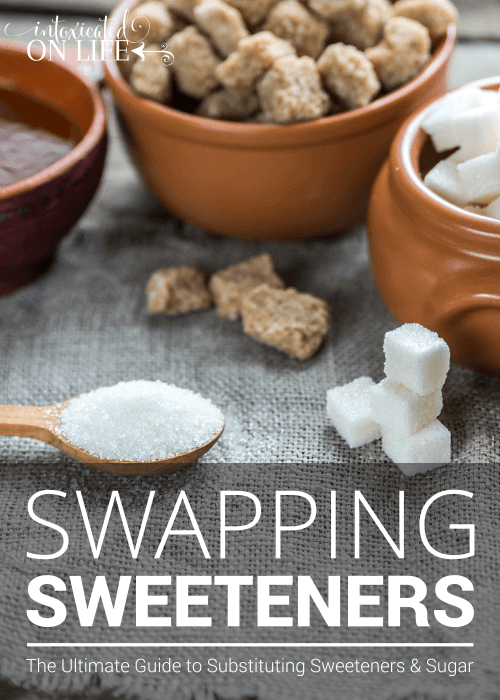
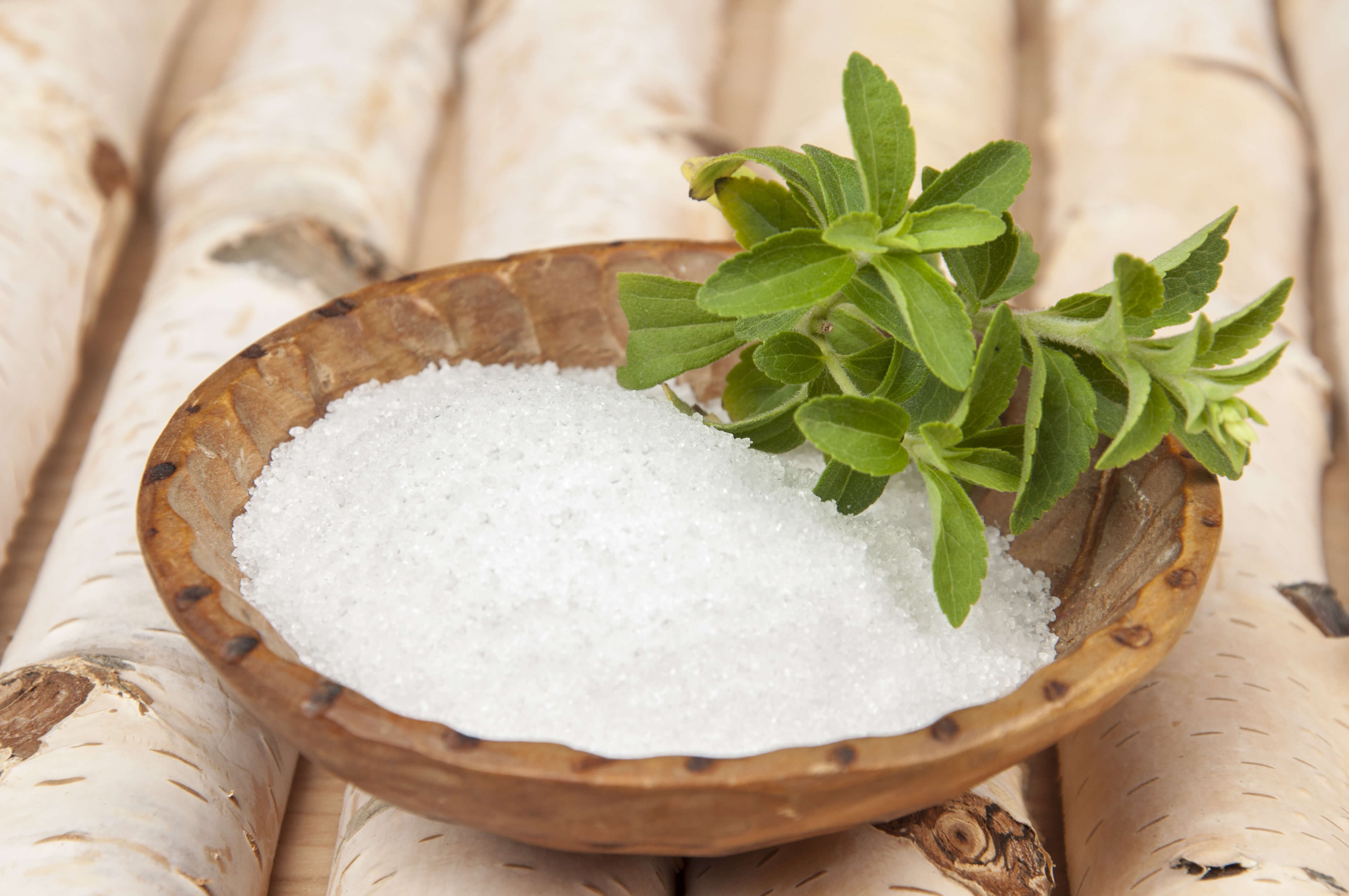
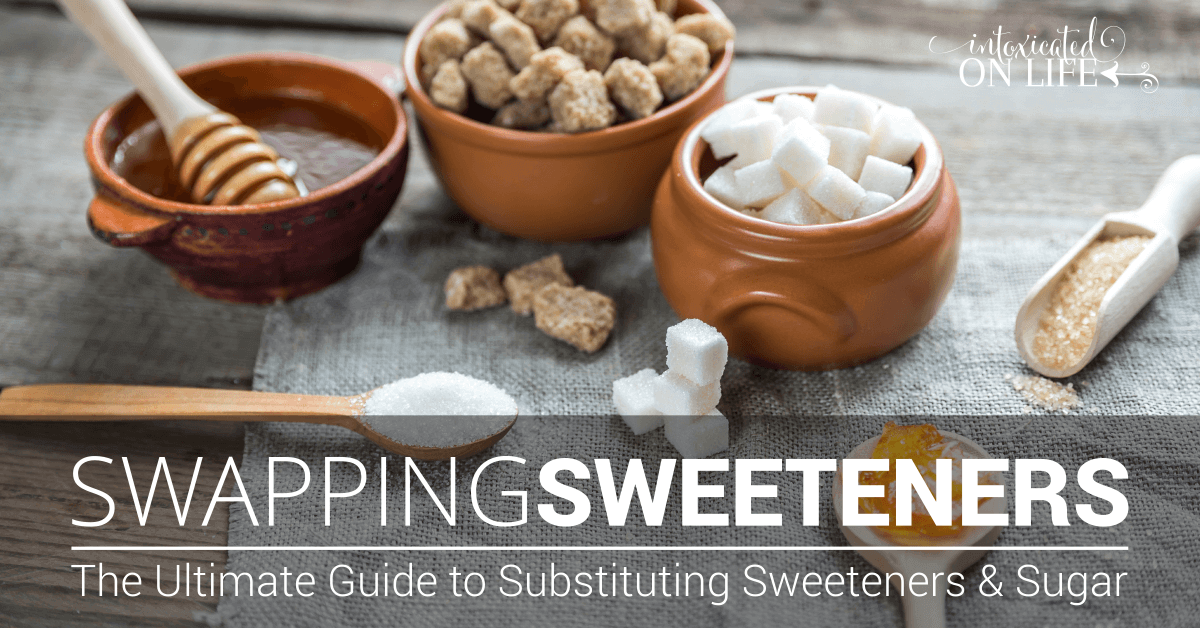
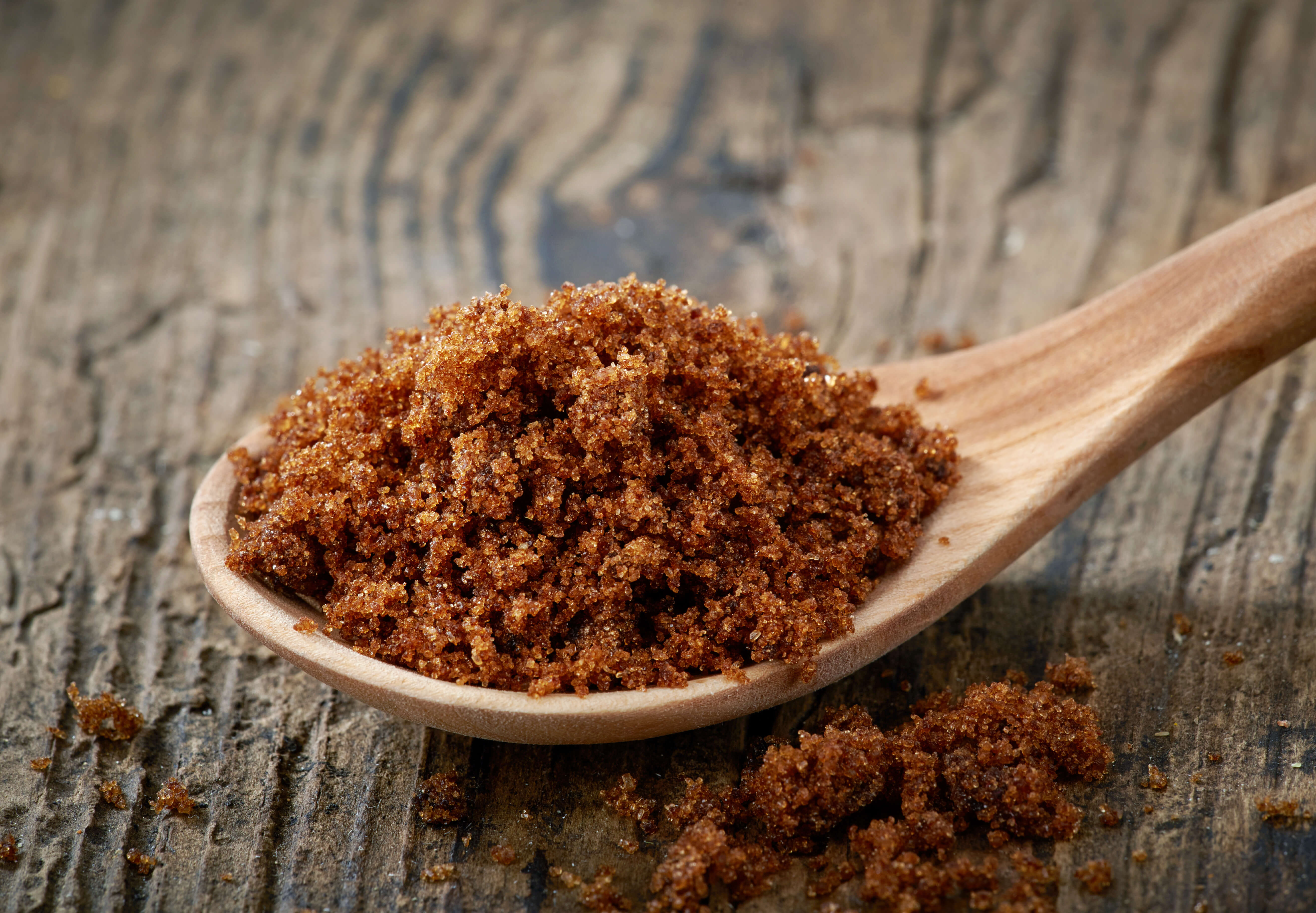
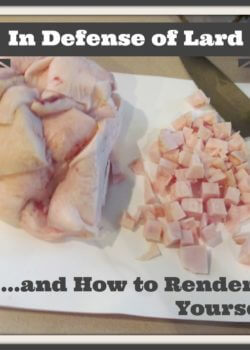
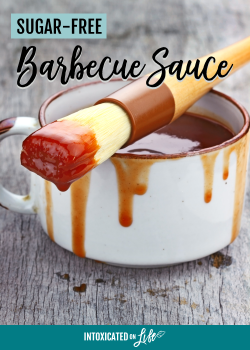
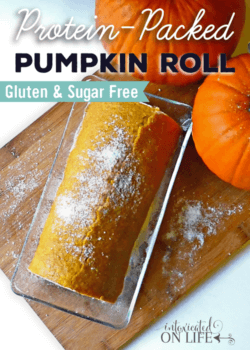
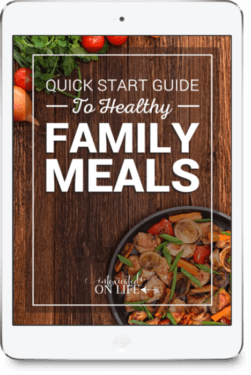

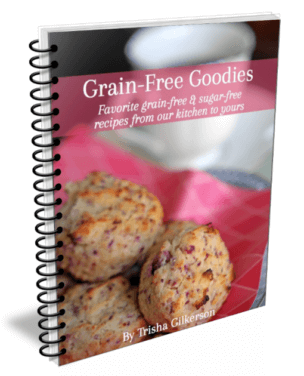

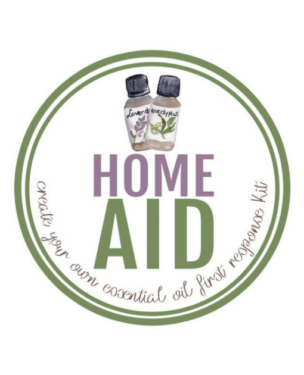

Trisha, I think I might have asked you this before, but what brand of xylitol/stevia do you buy and where do you get them? I found a pre-blended mix of the two on Thrive Market that I’ve been liking, but it’s a 0.5/1 replacement for sugar (half a cup of this blend equals one cup of sugar in sweetness) which doesn’t work great for baking. I’d love to buy the two separately and mix them myself as you suggest! Thank you for this article, definitely sharing it because it’s so helpful!
Hey Jaimie, I don’t have a specific brand of xylitol I buy, but do prefer to get one from birch trees because the kind that comes from corn is usually GMO. As far as stevia, I like NuNaturals pure stevia extract. It has no fillers and is super concentrated and goes a really long way. It tends to be less bitter than some of the other brands I’ve tried too. I just buy mine on Amazon 🙂
Thank you!! I currently have “Crystal White” which is made by “Beyond Sugar” apparently… it’s birch bark xylitol and organic stevia, not sure the ratios but 4 calories per 1/2 tsp and 2 grams of sugar alcohols. And this particular blend is double the sweetness of table sugar according to the package.
Where do you usually get your xylitol from?
Thoughts on organic cane?
Sorry for the delay in getting back to you! Organic cane sugar is pretty comparable to regular table sugar, but it’s slightly less processed. But for all intents and purposes you can swap it out in most any recipe for table sugar. Also, organic cane sugar comes from sugar cane whereas table sugar may come from either the sugar cane or the sugar beat.
Hi I would like to replace honey for Erythritol in a recipe. What ratio should I use and how much liquid should i add. I started with equal weight honey and sugar with 1/4 cup water but the biscuits were very dry. Any suggestions would be appreciated. Thanks Heather
I have cut out all forms of sugar for the past month except from fruit and have had more energy and not a single headache. I’m amazed. That being said, I need some baked goods back in my life occasionally. Are there any side effects from the first batch of sweeteners you mentioned? Really no more headaches and fatigue from them?
I don’t personally have any side effects from them at all. They are not metabolized like sugar, so it shouldn’t cause the headaches and fatigue. For some, if you eat too much xylitol it can cause some gastrointestinal distress, so just start slow. And like I mentioned in the article, I do part stevia and part xylitol so it cuts down the amount I use quite a bit. Congrats on getting rid of sugar! I think it’s harder to give up sugar than gluten.
I noticed you didn’t mention Monkfruit. What’s your thoughts on that one?
That’s one I haven’t had as much experience with yet, so I didn’t cover it in this post! Possibly in the future. 🙂
I’ve been using the Monk fruit and I love it! I found it to have the little cool taste without any bitter aftertaste and I use it equally to sugar. I got mine through Amazon Now product, it does come with the erythritol. I hope this helps. M
Do you use powdered or liquid artificial sweetners? I never see a reference in Keto friendly recipes indicating liquid or powdered.
I use powdered
I am surprised to find so many people using erythritol and other sugar alcohols. Studies have been done showing that these lower calorie alternatives to sugar often cause carbohydrate cravings (I have experienced such when using Stevias made with erythritol which was actually discovered when they were trying to make a better/more natural insecticide btw) because your body treats sugar alcohols the same as sugar and release extra insulin to compensate for the impending sweetness which then causes your blood sugars to drop because the glucose is not there to cover the extra insulin which then causes your liver to dump all the sugar it has stored for emergencies which then has to be replaced, hence the cravings. It is a very unhealthy cycle to put your body through even on a semi regular basis, let alone several times a day. And even as a “normal” person (non diabetic…which I am a type one btw before anyone jumps me for my wording), it is very dangerous to put yourself in a situation which could lead to a severe hypoglycemic episode a.k.a. a low sugar. I avoid these sugar alcohols in leu of just eating naturally sweetened (sugar, molasses or honey) items in moderation (i.e. a healthy portion size) with no issues concerning weight and/or blood sugar control. But what do I know? I have been doing this for 30 years…
Thank you for your personal insight and for referencing the science of sugar alcohols. I get horribly stomach aches from any sugar substitute. I wanted a substitute for erythritol and just decided to use sugar instead in the recipe and came upon this page. Again, thank you for speaking to those of us who can digest sugar substitutes like erythritol.
If a recipe asks for golden erythritol, can I use the white erythritol in place ?
what are your thoughts on pure sucralose ? we have been getting it and I mix some with a water and have it in a dropper bottle, to us it taste most like sugar but not sure if its truly safe to use.
I don’t think sucralose is as bad as some people make it out to be, but I’m not a huge fan of it and think there are better options out there. Here’s a post I wrote on sucralose you might find interesting.
This is the best article I’ve read on sugar subs in baking. Thank you. Now, how about flour subs?? What do you recommend? Coconut flour, almond?
We don’t yet have a post that has an overview of all the different grain-free flours, but our recipes for baked goods all use them. We like almond flour, coconut flour, and others!
I need to substitute 1 teaspoon of xylitol with Palm sugar so how much palm sugar is equivalent to 1 teaspoon of xylitol
Xylitol has the same sweetness as regular sugar, so as long as the palm sugar is about the same sweetness, you’d just use one teaspoon. Always adjust sweeteners to your taste! 🙂
What can I substitute for powdered erythrital?
Any other powdered low-glycemic sweetener (Swerve, Pyure, etc.). If you prefer xylitol you can use that instead. Any granulated sweetener can be powdered by grinding it in a small coffee grinder. Or, depending on the recipe, you can substitute pure stevia, either powdered or liquid, but you would use very little.
I can’t use any artificial sweeteners. I do use both erythritol and xylitol. I am curious about using half sugar with half erythritol for baking. I suppose the best solution would be to experiment in recipes.